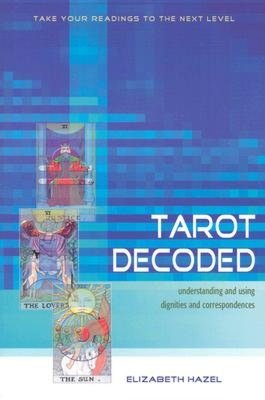
One of the many factors that separate amateur tarot students from the more serious tarot reader/scholar is the use of dignities (the relationship of cards in a tarot spread) and correspondences (relationships of tarot cards to other disciplines). Elizabeth Hazel’s Tarot Decoded does an excellent job of marrying the tarot with astrology primarily, but also discusses numerological influences of the cards as well.
Hazel’s discussion of the elements should be required reading for any metaphysical student regardless of specific discipline. Her descriptions are almost lyrical and poetic in nature, and they capture the essence of earth, air, fire, and water brilliantly. In many works, these don’t receive much treatment; I suspect that many authors rush over these in an almost “yeah, yeah, yeah, you know this but I have to say it anyway” sort of way. Hazel takes the amount of time required to really explain them, so that neophytes will not be lost but that advanced metaphysical students will take some knowledge away as well.
While you don’t need to be a professional astrologer to use this book, you will most definitely increase your knowledge of astrology here. Hazel links it up seamlessly with the tarot. You’ll want to bookmark the charts in the book, too. I would recommend having this book handy for that reason alone.
For me, where this book really shined was in how it left no stone unturned. Hazel really does a thorough job of exploring all of the areas where astrology and tarot meet: the elements; the modes (cardinal, fixed, and mutable qualities of the various signs); and correspondences with the astrological signs themselves as well as with the planets, showing in some cases both traditional and modern linkages (under “zodiacal dignities”, Scorpio’s ruler is listed as both Mars and Pluto, for example). This is especially important for the outer planets of Uranus, Neptune, and Pluto. The Golden Dawn correspondences are referenced primarily, but other systems such as Thoth are also mentioned.
I especially enjoyed the numerological associations. Personally, I don’t take advantage of this aspect of the tarot as much as I should, and Hazel provides example interpretations for the different numbers, and for good measure adds the major arcana numerical associations to round it out. I never considered an overall interpretation if I draw all four tens in a reading, for example; Hazel’s explanation of “Total collapse of current life path, leading to rebirth in a new form” for this situation gave me a new perspective that I found refreshing.
You’ll also like the spreads and the demonstrations/interpretations throughout the book. I’ve been working with an astrological house spread for some time, but Hazel’s “Zodiac Spiral Spread” just blew me away. Her brief but clear analysis of the spread helps to internalize it more quickly.
The only “problem” you will have with this book is that there is so much fantastic information here that you’ll want to tackle all of these different types of dignities and correspondences right away. If you’re anything like me, you’ll have a few different sets of flash cards—or an app for your smart phone—to start making them a permanent part of your tarot practice.
Tarot Decoded is an instant classic, and has become an important tool in my development as a tarot reader and an astrologer. I use it so much that it doesn’t make it to my shelf very often!
In short, I can’t think of a more comprehensive, well-written, serious book on tarot and astrology than Tarot Decoded, and I can’t recommend it enough for tarot students who are ready to take their individual practice to the next level.
~review by John Marani
Author: Elizabeth Hazel
Weiser Books, 2004
$18.95
